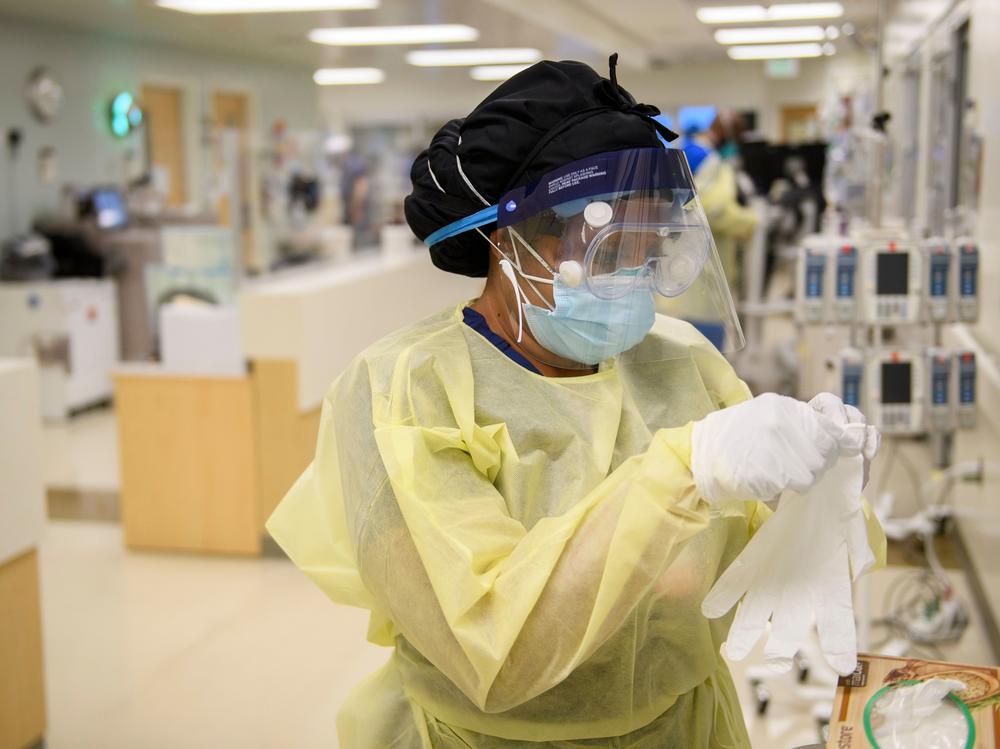Section Branding
Header Content
Federal COVID Workplace Safety Rules Are Here. But Only For Health Care Workers
Primary Content
Fifteen months into the pandemic, the Occupational Safety and Health Administration has issued a mandatory workplace safety rule aimed at protecting workers from COVID-19. But it only applies to health care settings, a setback for unions and worker safety advocates who had called for much broader requirements.
Called an emergency temporary standard, the rule takes effect as soon as it's published in the Federal Register and can remain in place for up to six months, during which a permanent rule could be considered.
The new rule mandates that employers develop and implement a COVID-19 plan and take steps to reduce the chance of transmission, including keeping people at least 6 feet apart indoors, installing barriers between workstations where distancing is not possible, ensuring ventilation systems are working properly, and providing and ensuring each employee wears a face mask when indoors, or a respirator and other personal protective equipment when exposed to people with suspected or confirmed cases of COVID-19.
For unvaccinated workers, employers are now required to provide paid time off to get vaccinated and to recover from any side effects from the shots.
Some of the language in the rule is vague and appears open to interpretation. For example, fully vaccinated workers are exempt from the requirements when they are in well-defined areas where there is "no reasonable expectation" they will be exposed to the virus.
Rule covers more than 10 million workers
Jim Frederick, OSHA's acting administrator, estimates there are 10.3 million people working in places that will have to comply with the requirements, including hospitals, nursing homes and assisted living facilities. The rule also covers emergency responders and home health care workers. Not included are people who work in other medical settings such as medical or dental offices.
"Following an extensive review of the science and data, OSHA determined that a health care-specific requirement will make the biggest impact," Labor Secretary Marty Walsh said on a call with reporters. Acknowledging the months that have gone by since the Labor Department first considered issuing this rule, he added, "We know it's been a long time coming."
The United Food and Commercial Workers union, which represents 1.3 million workers, is among a number of groups decrying the rule's narrow scope.
"Today's new COVID workplace safety standard from OSHA represents a broken promise to the millions of American workers in grocery stores and meatpacking plants who have gotten sick and died on the frontlines of this pandemic," UFCW International President Marc Perrone said in a statement. "Vaccinations are helping us take control of this pandemic, but the danger for these essential workers is far from over."
Previous COVID-19 standards were voluntary
It's the first time in the pandemic that OSHA has imposed any requirements about COVID-19 workplace safety on employers. Until now, OSHA had only issued recommendations for measures employers could voluntarily take to keep workers safe. During the campaign, President Biden criticized the Trump administration for not doing more.
The bar for issuing an emergency temporary standard is high. OSHA must determine that workers are in "grave danger" due to exposure to toxic substances or new hazards and that an emergency rule is necessary for their protection, according to OSHA's website.
At a hearing Wednesday of the House Committee on Education and Labor, Walsh, the labor secretary, faced questions about whether a grave danger still exists for American workers.
Pressed by Republican Rep. Tim Walberg of Michigan, Walsh said he was not a scientist and could not answer the question fully. But he added, "I like the signs of where we're headed with COVID-19. I love the fact that our numbers are going down. However, people are still dying, and people are still getting infected."
Business groups say rules are an unnecessary burden
For months, the business community has argued that an emergency temporary standard could no longer be justified and would be a burden to businesses recovering from the pandemic. The CDC's May 13 guidance that fully vaccinated people no longer needed masks indoors became a talking point.
"A lot of employers are pushing their employees to get vaccinated. Clearly, a lot of workplaces have high levels of people being vaccinated. That really undermines any argument OSHA would have for claiming grave danger," said Marc Freedman, vice president of employment policy at the U.S. Chamber of Commerce, after that guidance was issued.
Meanwhile, worker safety advocates pointed to the change in mask guidance and the dropping of state and local mask ordinances as key reasons OSHA still needed to act.
"Across the country, people have taken off their masks. They're not social distancing. Employers aren't cranking up the ventilation anymore," former OSHA Administrator David Michaels said in May. "That's a terrible mistake. There are so many unvaccinated people who are at risk for this deadly virus."
Michaels, now a professor at the George Washington University School of Public Health, said that the new rule is better than no rule, but that if exposure to the virus is not controlled in high-risk industries such as meat processing, corrections and retail establishments, those industries will continue to drive infections as more infectious variants take over and large numbers of people remain unvaccinated.
Copyright 2021 NPR. To see more, visit https://www.npr.org.

